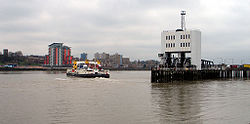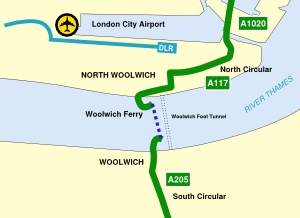Woolwich Free Ferry
| 35px London River Services | |
|---|---|
| Woolwich Free Ferry | |
 The ferry crossing the Thames | |
| Locale | River Thames, London, UK |
| Vessels | 2 |
| Length (km) | 0.4km |
| Transit type | Car and passenger ferry |
| Began operation | 23 March 1889 |
| No. of lines | 1 |
| No. of terminals | 2 |
| Owner | London River Services |
| Operator | Serco |
| London River Services | |
| |
| |
This article needs additional citations for verification. Please help improve this article by adding reliable references. Unsourced material may be challenged and removed. (September 2008) |
The Woolwich Free Ferry is a boat service across the River Thames, London, UK, which is licensed and financed by London River Services, the maritime arm of Transport for London. The service is operated by Serco Group under licence from TfL and carries both foot passengers and vehicles.[1]
The service links Woolwich in the London Borough of Greenwich with North Woolwich in the London Borough of Newham. It also links two ends of the inner London orbital road routes: the North Circular and the South Circular.
Contents
Services
On weekdays, the ferry operates from 6.10am until 8pm with a two-boat service (10 minutes nominal interval between sailings); on Saturdays, from 6.10am to 8pm with a one-boat service (15 minutes nominal interval, and the last south-to-north sailing is 15 minutes earlier at 7.45pm); on Sundays, from 11.30am to 7.30pm with a one-boat service (last south-to-north sailing at 7.15pm).
The ferries can carry lorries and other road traffic across the river, plus large numbers of foot passengers (licensed capacity: 500 passengers and 200 tonnes of vehicles).
History
A ferry service had operated across the river at Woolwich since at least the fourteenth century. The free ferry service was instigated by Sir Joseph Bazalgette using powers granted in the Metropolitan Board of Works (Various Powers) Act 1885.
The service was officially opened on 23 March 1889. Two days before this happened the Metropolitan Board of Works was replaced by the London County Council (LCC). The LCC continued to operate the ferry until it was replaced by the Greater London Council (GLC) on 31 March 1965. After the abolition of the GLC in 1986 the responsibility for operating the service was transferred to the Secretary of State for Transport, who contracted the London Borough of Greenwich to run the service. Asset ownership and operating rights were subsequently transferred to Transport for London (TfL) on the establishment of the Greater London Authority, but the London Borough of Greenwich continued to operate the ferry on behalf of TfL.[2]
In March 2008, the London Borough of Greenwich gave TfL notice that it would cease operating the service from 30 September 2008. On 12 September 2008 TfL announced that Serco Group would take over the operation of the service from 1 October 2008. The contract runs until 31 March 2010.[1]
Nearest alternative crossings
If the ferry service is not operating (it may occasionally be suspended due to fog during its normal hours) pedestrians can use the nearby Woolwich foot tunnel from Woolwich to North Woolwich.
A Docklands Light Railway (DLR) station, Woolwich Arsenal on the south side of the Thames, was opened in January 2009 as the new terminus of the London City Airport branch. A DLR station near to the north ferry dock is King George V DLR station.
The nearest vehicle alternatives are the Blackwall Tunnel about two miles (3 km) upstream to the west, or the Dartford Crossing some ten miles (16 km) downstream to the east but both of these tunnels have height restrictions for lorries.
Fleet
The current three vessels (built in Dundee in 1963 by the Caledon Shipbuilding & Engineering Company to replace the previous four paddle steamers used since 1923) were each named after prominent local politicians: John Burns, Ernest Bevin and James Newman (Newman was mayor of Woolwich, 1923-25). This continued a practice started in 1923 with The Squire (named after William Squires, another former mayor of Woolwich), and in 1930 with the Will Crooks (Labour MP for Woolwich, 1903-1921) and the John Benn (Sir John was a member of London County Council, Liberal MP for Wapping, and grandfather of Tony Benn).
The ferries feature Voith-Schneider propulsion systems for manoeuvrability.
Running cost
For the 18 months of their contract, Serco are being paid £10.7 million to provide the free ferry service.[3] This equates to £7.1 million per year.
In 2003, when the annual running cost of the ferry was around £5 million a year, the effective public subsidy per vehicle crossing was £4.
Passenger numbers
The ferry carries more than one million vehicles and 2.5 million passengers each year.[4] Occupants of vehicles (including drivers) are counted as passengers.
Ferry patronage is still high for vehicles, but has fallen away to minimal numbers for foot passengers. At all times of day, but particularly at peak hours, it is common for vehicles to have to queue beyond the next ferry departure; regular users know the lengths of the vehicle queues, and when it becomes worthwhile to turn away to the Blackwall tunnel. Several rearrangements and improvements have been made to the vehicle queueing arrangements over the years, especially to avoid impact on other local traffic.
The passenger deck is beneath the vehicle deck, and on crossings nowadays the very substantial accommodation provided, both seated and standing, is normally virtually empty.
For foot passengers, bus services converge on both terminals, on the north side there is a small bus station, but many cross-river foot passengers take the foot tunnel beneath the river, alongside the ferry route. Further competition arrived in 2009 with the extension of the Docklands Light Railway to Woolwich, which crosses under the river to the east of the ferry route.
Future of the service
The ferry service currently exists because it provides an alternative river crossing for vehicles (especially lorries). As long as there is a demand for a vehicle ferry it is unlikely to be discontinued and in any case would require an Act of Parliament to do so.
In 2004 planning applications were submitted for a new bridge, the Thames Gateway Bridge, close to the location of the Woolwich Ferry. However the project was cancelled in November 2008.[5] If the bridge were to be built then it is likely that the ferry service would be withdrawn as it would no longer be required.
The Woolwich Ferry has been in service for 120 years.
External links
- Official Web page of the ferry
- http://www.yellins.co.uk/woolwichferry In depth website about the Woolwich Ferry
- London River Services timetable - Transport for London
- London Landscape TV episode (4 mins) about the Woolwich Ferry
- BBC London report about the Woolwich Ferry (video, 01:41)
References
- ↑ 1.0 1.1 "Transport for London appoints Serco to operate the Woolwich Ferry service". Transport for London. 2008-09-12. http://www.tfl.gov.uk/corporate/media/newscentre/9346.aspx. Retrieved 2008-09-25.
- ↑ "The Woolwich Free Ferry". http://www.yellins.co.uk/woolwichferry/. Retrieved 2008-10-13.
- ↑ http://www.london.gov.uk/mayor/mayors_report/2008docs/mayors_report_sep08.pdf
- ↑ http://www.tfl.gov.uk/assets/downloads/corporate/businessplandec2007.pdf
- ↑ "Mayor outlines ten year plan for massive transport expansion". Mayor of London. http://www.tfl.gov.uk/corporate/media/newscentre/archive/10231.aspx. Retrieved 2008-11-10.
| ||||||||
| |||||||||||||||||||||||||
- Pages using duplicate arguments in template calls
- Pages with broken file links
- Articles needing additional references from September 2008
- Articles with invalid date parameter in template
- All articles needing additional references
- Articles with OS grid coordinates
- Transport in Newham
- Transport in Greenwich
- London River Services
- Ferries across the River Thames
- No-fee ferries

